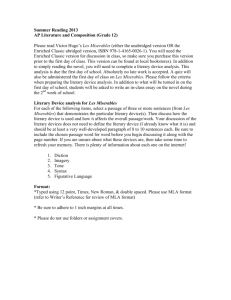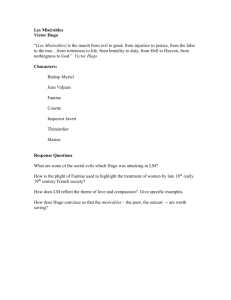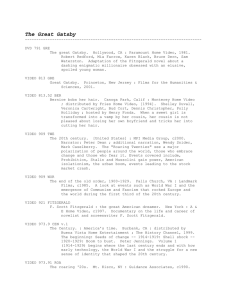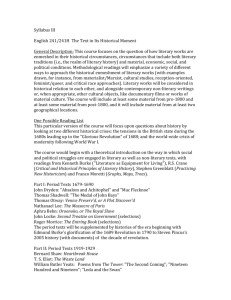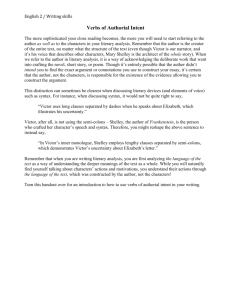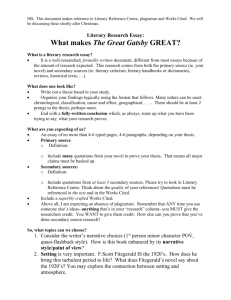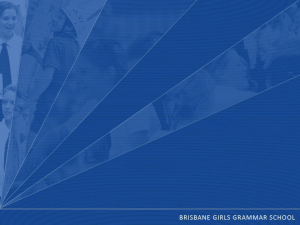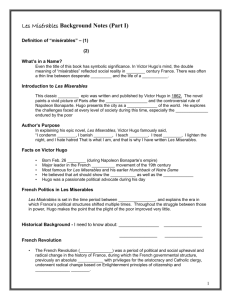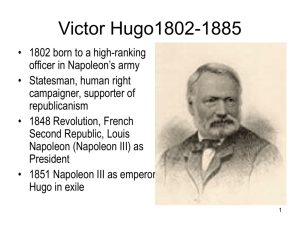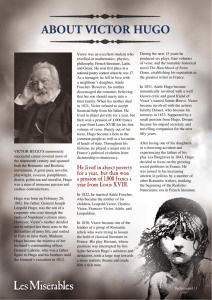ÇAĞ UNIVERSITY
advertisement
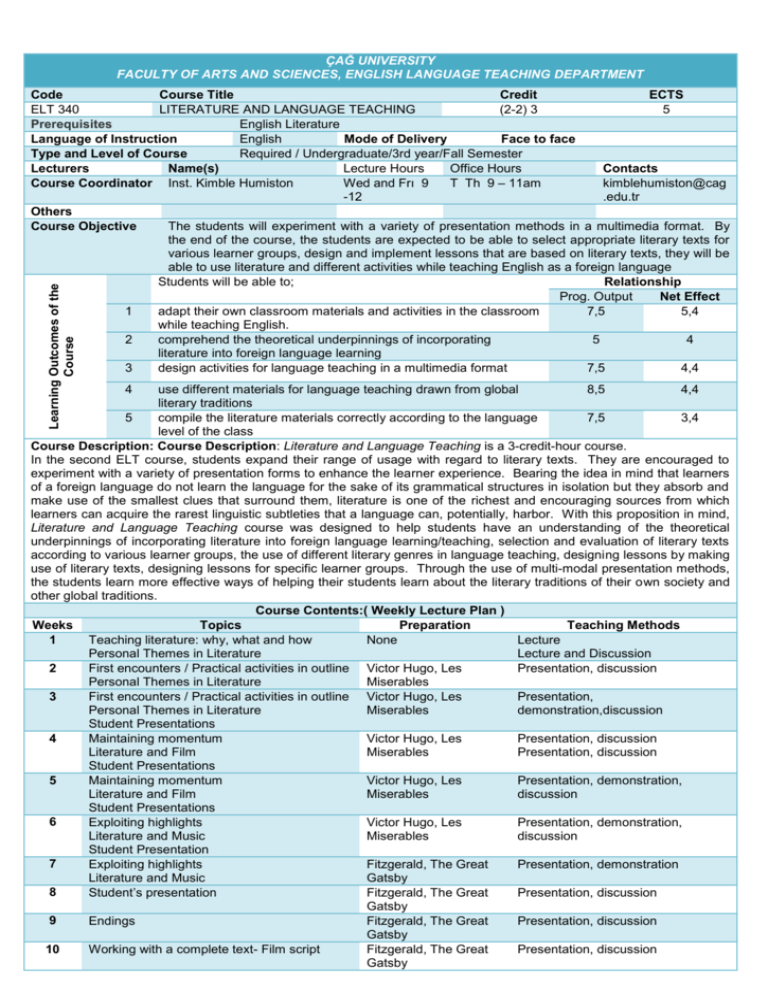
ÇAĞ UNIVERSITY FACULTY OF ARTS AND SCIENCES, ENGLISH LANGUAGE TEACHING DEPARTMENT Learning Outcomes of the Course Code Course Title Credit ECTS ELT 340 LITERATURE AND LANGUAGE TEACHING (2-2) 3 5 Prerequisites English Literature Language of Instruction Mode of Delivery Face to face English Type and Level of Course Required / Undergraduate/3rd year/Fall Semester Lecturers Name(s) Contacts Lecture Hours Office Hours Course Coordinator Inst. Kimble Humiston Wed and Frı 9 T Th 9 – 11am kimblehumiston@cag -12 .edu.tr Others Course Objective The students will experiment with a variety of presentation methods in a multimedia format. By the end of the course, the students are expected to be able to select appropriate literary texts for various learner groups, design and implement lessons that are based on literary texts, they will be able to use literature and different activities while teaching English as a foreign language Relationship Students will be able to; Net Effect Prog. Output 1 adapt their own classroom materials and activities in the classroom 7,5 5,4 while teaching English. 2 comprehend the theoretical underpinnings of incorporating 5 4 literature into foreign language learning 3 design activities for language teaching in a multimedia format 7,5 4,4 4 use different materials for language teaching drawn from global 8,5 4,4 literary traditions 5 compile the literature materials correctly according to the language 7,5 3,4 level of the class Course Description: Course Description: Literature and Language Teaching is a 3-credit-hour course. In the second ELT course, students expand their range of usage with regard to literary texts. They are encouraged to experiment with a variety of presentation forms to enhance the learner experience. Bearing the idea in mind that learners of a foreign language do not learn the language for the sake of its grammatical structures in isolation but they absorb and make use of the smallest clues that surround them, literature is one of the richest and encouraging sources from which learners can acquire the rarest linguistic subtleties that a language can, potentially, harbor. With this proposition in mind, Literature and Language Teaching course was designed to help students have an understanding of the theoretical underpinnings of incorporating literature into foreign language learning/teaching, selection and evaluation of literary texts according to various learner groups, the use of different literary genres in language teaching, designing lessons by making use of literary texts, designing lessons for specific learner groups. Through the use of multi-modal presentation methods, the students learn more effective ways of helping their students learn about the literary traditions of their own society and other global traditions. Course Contents:( Weekly Lecture Plan ) Weeks Topics Preparation Teaching Methods 1 Teaching literature: why, what and how None Lecture Personal Themes in Literature Lecture and Discussion 2 First encounters / Practical activities in outline Victor Hugo, Les Presentation, discussion Personal Themes in Literature Miserables 3 First encounters / Practical activities in outline Victor Hugo, Les Presentation, Personal Themes in Literature Miserables demonstration,discussion Student Presentations 4 Maintaining momentum Victor Hugo, Les Presentation, discussion Literature and Film Miserables Presentation, discussion Student Presentations 5 Maintaining momentum Victor Hugo, Les Presentation, demonstration, Literature and Film Miserables discussion Student Presentations 6 Exploiting highlights Victor Hugo, Les Presentation, demonstration, Literature and Music Miserables discussion Student Presentation 7 Exploiting highlights Fitzgerald, The Great Presentation, demonstration Literature and Music Gatsby 8 Student’s presentation Fitzgerald, The Great Presentation, discussion Gatsby 9 Endings Fitzgerald, The Great Presentation, discussion Gatsby 10 Working with a complete text- Film script Fitzgerald, The Great Presentation, discussion Gatsby 11 Working with a complete text- Film scripts Multimedia presentations Working with a complete text- World Literature Multimedia presentations Student Multimedia Presentations 12 13 Hemingway, The Sun Also Rises Hemingway, The Sun Also Rises Presentation, discussion Presentation, discussion Hemingway, The Sun Presentation, discussion Also Rises 14 Student Multimedia Presentations Hemingway, The Sun Also Rises REFERENCES Textbook Teaching literature in the language classroom , Jennifer Hill, Cambridge Press Course Notes Literature in the language classroom: a resource book of ideas and activities By Joanne Collie, Stephen Slater , Cambridge Press Personal Themes in Literature The Multicultural Experience, Sally Jorgensen and Valerie Whiteson, Prentice Hall Turkish Legends and Folk Poems, Talat Halman,Dost Yayinlari TeacherVision Website, TeacherVision.com Victor Hugo, Les Miserables. Gutenberg Project. 2008. F. S. Fitzgerald, The Great Gatsby. Gutenberg Project. 2010. Ernest Hemingway, The Sun Also Rises. University of Pennsylvania On-Line Archive. 2010. ASSESSMENT METHODS Activities Number Effect Notes Midterm Exam 1 35% Presentation & micro1 15% teaching 50% Effect of The Activities 50% Effect of The Final Exam ECTS TABLE Contents Number Hours Total Hours in Classroom 14 3 42 Hours out of Classroom 14 1 14 Homework Presentation & micro teaching 5 3 15 Quizzes Midterm Exam 1 24 24 Final Exam 1 25 25 Total 120 Total / 30 120/30 ECTS Credit 4 RECENT PERFORMANCE 2014 SPRING SEMESTER ELT 340 L?TERATURE AND LANGUAGE TEACHING 9 8 8 10 8 6 6 5 4 4 4 2 0 0 0 0 -2 NA FF FD DD DC CC CB BB BA AA MAN 307 BUSINESS FINANCE LEARNING GOALS 1. Be able to define Finance and the role of Financial Manager and to explain how financial markets and institutions channel savings to corporate investment. a. Give examples of investment and financing decisions that financial managers make b. Distinguish the difference between real and financial assets c. Cite some of the advantages and disadvantages of organizing a business as a corporation d. Describe the responsibilities of the CFO, treasurer, and controller e. Explain why maximizing market value is the logical financial goal of the corporation f. Explain why maximization is usually consistent with ethical behavior g. Explain how corporations mitigate conflicts and encourage corporate behavior h. Know the basic functions of the corporations and the role of the corporations in financial markets i. Explain the functions of financial markets & financial institutions j. Define the basic financial assets traded in financial markets k. Define the actors of financial markets: financial institutions l. Use the cost of capital concept for individual and for corporate investment in financial markets 2. Be able to differ the type of interest rates and calculate FV of money invested, PV of a future payment, annuities and set the Cash Flow. a. Define interest and understand the time value of money b. Know the types of interest and its basic components c. Use to set up cash flow diagram d. Practice by using simple interest tecniques e. Learn to use compounding formulas f. Calculate FV of an initial investment and a series of cash payments g. Apply the calculation techniques to real life problems h. Define the PV (Present Value) concept and differ it from FV i. Know the concept of discounting and the difference from interest j. Use to set up cash flow diagram k. Learn to use discounting formulas l. Calculate PV of a future payment and a series of cash payments m. Apply the calculation techniques to real life problems 3. Be able to explain the chracteristics and types of Bonds and calculate the market price of a bond given its yield to maturity and vice versa. a. Define a bond and know basic characteritics and the types of bonds b. Distinguish among a bond’s coupon rate, current yield and yield to maturity c. Show why bonds exhibit interest rate risk d. Understand why investors pay attention to bond ratings e. Calculate the market price of a bond given its yield to maturity f. Finsd a bond’s yield given its price g. Demonstrate why prices and yields vary inversely 4. Be able to explain the chracteristics and types of Stocks and to use basic Stocks Valuation Methods a. Define a stock and recall basic characteritics and the types of stocks b. Understand the stock trading reports in the financial pages of newspapers and other media c. Calculate the PV of a stock given forecasts of the future dividends and future stock price d. Use the stock valuation formulas to infer the expected rate of return on a common stock e. Interpret price/earnings ratios 5. Be able to demonstrate the basic rules of Risk, Return and Opportunity Cost of Capital. a. Measure and interpret the market risk, or beta of a security b. Relate the market risk of a security to the rate of return that investors demand c. Calculate the opportinity cost of capital for a project 6. Be able to use Evaluation Techniqes in Capital Budgeting and to apply on projects. a. Calculate the net present value of an investment (NPV) b. Calculate the internal rate of return (IRR) and to look out for when using it c. Explain why the payback rule doesn’t always make shareholders better off. d. Calculate the profitability index and use it to choose between projects when funds are limited 7. Be able to explain the fundamentals of Corporate Financing. a. Explain why managers should assume that the securities they issue are fairly priced b. Describe the major classes of securities sold by the firm c. Summarize the changing ways that Turkish Firms have financed their growth 8. Be able to calculate WACC and use it for Company Valuation a. Calculate a firm’s capital structure b. Estimate the required rates of return on the securities issued by the firm c. Calculate the weighted-average cost of capital d. Understand when WACC is or isn’t the appropriate discount rate for a new project e. Use WACC to value a business given forecasts of its future cash flows

